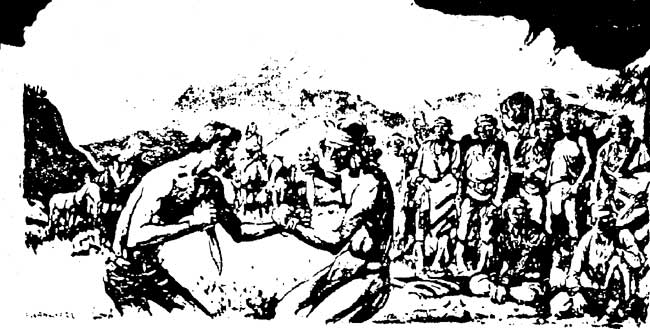

Pagosa Spring in southwestern Colorado is unique for many reasons. It is probably the largest hot spring in the world. At least two men foolhardy enough to bet they could swim across the spring have been boiled to a soupy tenderness. Snow melts as fast as it falls on the ground surrounding the spring, and in winter it isn't unusual to see a baseball game and a skiing tourney going on within 200 yards of each other. Pagosa Spring is also the site of one of the strangest duels in history, fought there some seventy-five years ago. Indians who originally discovered the spring called it Pagosa, meaning, "healing water," and every year came to soak winter pains out of their bones in the mud flats south of the big pool. The spring is in the San Juan Valley, where game is plentiful. There is no reason why two tribes of Indians couldn't have shared the valley and surrounding mountains, but instead the Navajos and Utes waged a 200-year war there. The ceaseless battles took their toll, and tribal leaders began to see a world in which there would be neither Navajos nor Utes. A powwow was called, and a rather sensible way of settling the _2500-year war was decided. Each tribe would pick its best man, and the two would end the feud in hand-to-hand combat. A rocky plateau overlooking Stollsteimer Creek, five miles southwest of the hot springs, was chosen for the scene of the fight. The Navajos selected a huge buck more than 6 feet tall to represent their tribe. The Utes had adopted into their band a Dutchman, Colonel Albert Pfeiffer, one-time scout with Kit Carson. In spite of his small stature was as full of fight as a cornered wildcat. Colonel Pfeiffer was particularly handy with a Bowie knife, and as knives had been selected as weapons, he begged for, and was given the right to represent his blood brothers, the Utes. Pfeiffer and the Navajo met in the huge circle of stone-faced spectators. They stared at each other as expressionless as the watchers, while their left wrists were strapped together with rawhide. Each clutched a knife in his right hand. Death waited to claim the loser. The signal was given to begin. With a mighty whoop the Navajo lunged at the Dutchman. The tremendous size of the Indian was both an advantage and a disadvantage. With the power of his left arm, | he almost swung Pfeiffer off his feet. But his size also made him slower. The razor edge knife buried itself in Pfeiffer's shoulder. Blood spurted on both contestants, and slid down their greasy bodies. The Dutchman sliced twice. He knew that a stab and the precious time wasted in withdrawing the blade might decide the battle. Again the Indian's knife flashed and descended. The Dutchman twisted and the steel grazed his neck. His own blade darted in and out, making ribbons of the Indian. Both were bleeding profusely, and Pfeiffer felt his strength sapping. The Navajo was longer-armed; only if they closed in could they battle as equals. The wiry Dutchman struck out with his feet catching the Indian off balance, and the two tumbled to the ground. Now, even the stoicism of the watchers broke. They crowded in for the coup de grace. The struggling figures on the ground twisted, stabbed, and writhed in death-lock. The knife blades clashed together. Then suddenly all was still. The Navajo's head fell back limply: his arm twitched, raised, dropped, and the knife fell from his fingers. His eves rolled in their sockets and came to blank rest on the serene blue-sky overhead. A low wail of lament from his tribesmen-the battle was over. Pfeiffer half lay over the Navajo. The Utes unstrapped their champion from his dead adversary and carried him to a bed of grass. While the Navajos sang the death chant over their dead warrior, the Ute medicine men doctored their own victor. They put cobwebs and powder from the puffball on his wounds to check the blood flow. They forced an 'herb brew past his white lips. Eventually he opened his eyes, and a glad cry went up from his adopted tribesmen. Peace had come to the San Juan-the first peace in the history of any living man. The two tribes gathered rocks and erected a monument. That night the Navajos camped a few miles south of the stone marker. The Utes set up their campsite above the great hot springs. There, they returned every summer until the government built Fort Lewis on the spot, and forced the Indians to live on reservations. —Dick Nossaman |